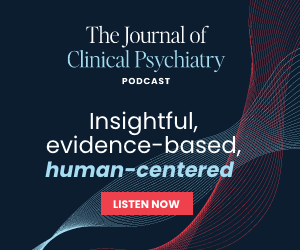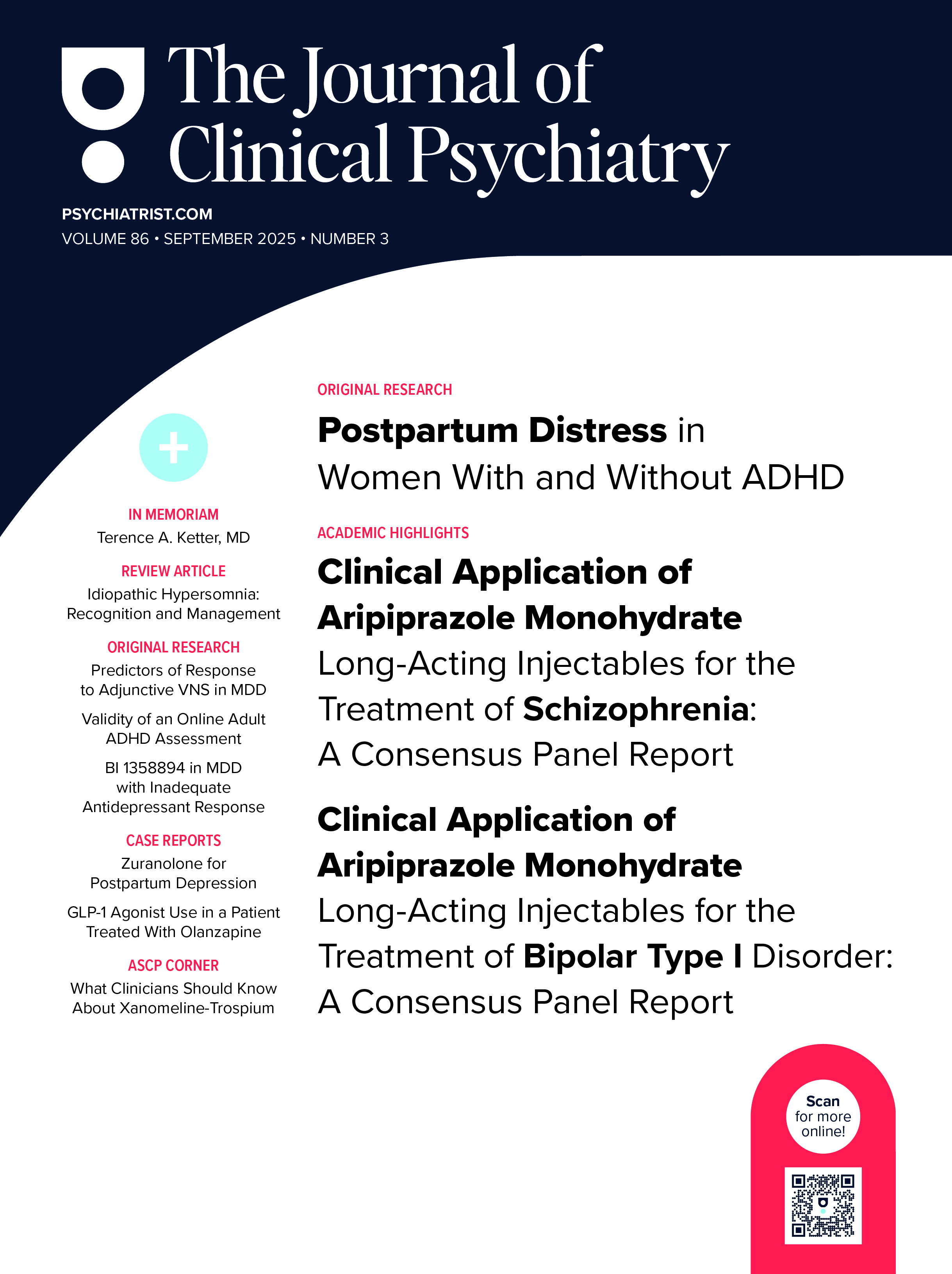
ABSTRACT
Objective: The risk of diabetes development has been reported to differ among second-generation antipsychotics (SGAs). However, few studies have focused on the subthreshold change in glycated hemoglobin (HbA1c). Therefore, this study examined the subthreshold change in HbA1c and change in body mass index (BMI) 3 months after patients initiated one of 6 SGAs widely prescribed in Japan.
Methods: This is a prospective cohort study of patients followed up based on the Japanese blood glucose monitoring guidelines for patients with schizophrenia. We collected eligible patients’ demographic data, medication history, blood tests, and weight measurements both at baseline and 3 months after recruitment, between April 2013 and March 2015. In the 378 patients with schizophrenia, schizoaffective disorder, and bipolar disorder based on ICD-10, we compared the subthreshold change in HbA1c and the change in BMI 3 months after antipsychotic initiation by using multivariate regression analysis.
Results: The subthreshold change in HbA1c 3 months after initiating blonanserin was significantly lower compared with olanzapine (B = −0.17, 95% CI = −0.31 to −0.04). In addition, the change in BMI 3 months after initiating blonanserin and aripiprazole was significantly lower compared with olanzapine (B = −0.93, 95% CI = −1.74 to −0.12; B = −0.71, 95% CI = −1.30 to −0.12, respectively).
Conclusions: This is the first study to clarify the differences in the subthreshold change in HbA1c among SGAs. Our results suggest that blonanserin is likely to be a favorable treatment for patients with high risk of diabetes.
Trial Registration: UMIN Clinical Trial Registry identifier: UMIN000009868
Members Only Content
This full article is available exclusively to Professional tier members. Subscribe now to unlock the HTML version and gain unlimited access to our entire library plus all PDFs. If you’re already a subscriber, please log in below to continue reading.
References (41)

- Taipale H, Tanskanen A, Mehtälä J, et al. 20-year follow-up study of physical morbidity and mortality in relationship to antipsychotic treatment in a nationwide cohort of 62,250 patients with schizophrenia (FIN20). World Psychiatry. 2020;19(1):61–68. PubMed CrossRef
- Tanskanen A, Tiihonen J, Taipale H. Mortality in schizophrenia: 30-year nationwide follow-up study. Acta Psychiatr Scand. 2018;138(6):492–499. PubMed CrossRef
- Tiihonen J, Lönnqvist J, Wahlbeck K, et al. 11-year follow-up of mortality in patients with schizophrenia: a population-based cohort study (FIN11 study). Lancet. 2009;374(9690):620–627. PubMed CrossRef
- De Hert M, Detraux J, van Winkel R, et al. Metabolic and cardiovascular adverse effects associated with antipsychotic drugs. Nat Rev Endocrinol. 2011;8(2):114–126. PubMed CrossRef
- Henderson DC, Vincenzi B, Andrea NV, et al. Pathophysiological mechanisms of increased cardiometabolic risk in people with schizophrenia and other severe mental illnesses. Lancet Psychiatry. 2015;2(5):452–464. PubMed CrossRef
- Ray WA, Chung CP, Murray KT, et al. Atypical antipsychotic drugs and the risk of sudden cardiac death. N Engl J Med. 2009;360(3):225–235. PubMed CrossRef
- Vancampfort D, Correll CU, Galling B, et al. Diabetes mellitus in people with schizophrenia, bipolar disorder and major depressive disorder: a systematic review and large scale meta-analysis. World Psychiatry. 2016;15(2):166–174. PubMed CrossRef
- Cao H, Meng Y, Li X, et al. The metabolic effects of antipsychotics in the early stage of treatment in first-episode patients with schizophrenia: A real-world study in a naturalistic setting. J Psychiatr Res. 2020;129:265–271. PubMed CrossRef
- Godin O, Leboyer M, Schürhoff F, et al; FACE-SZ (FondaMental Academic Centers of Expertise for Schizophrenia) group. Predictors of rapid high weight gain in schizophrenia: longitudinal analysis of the French FACE-SZ cohort. J Psychiatr Res. 2017;94:62–69. PubMed CrossRef
- Choong E, Bondolfi G, Etter M, et al. Psychotropic drug-induced weight gain and other metabolic complications in a Swiss psychiatric population. J Psychiatr Res. 2012;46(4):540–548. PubMed CrossRef
- Mackin P, Bishop D, Watkinson H, et al. Metabolic disease and cardiovascular risk in people treated with antipsychotics in the community. Br J Psychiatry. 2007;191(1):23–29. PubMed CrossRef
- Stahl SM, Mignon L, Meyer JM. Which comes first: atypical antipsychotic treatment or cardiometabolic risk? Acta Psychiatr Scand. 2009;119(3):171–179. PubMed CrossRef
- Hirsch L, Yang J, Bresee L, et al. Second-generation antipsychotics and metabolic side effects: a systematic review of population-based studies. Drug Saf. 2017;40(9):771–781. PubMed CrossRef
- Selvin E, Steffes MW, Zhu H, et al. Glycated hemoglobin, diabetes, and cardiovascular risk in nondiabetic adults. N Engl J Med. 2010;362(9):800–811. PubMed CrossRef
- Henderson DC, Cagliero E, Copeland PM, et al. Elevated hemoglobin A1c as a possible indicator of diabetes mellitus and diabetic ketoacidosis in schizophrenia patients receiving atypical antipsychotics. J Clin Psychiatry. 2007;68(4):533–541. PubMed CrossRef
- Steylen PM, van der Heijden FM, Hoogendijk WJ, et al. Glycosylated hemoglobin as a screening test for hyperglycemia in antipsychotic-treated patients: a follow-up study. Diabetes Metab Syndr Obes. 2015;8:57–63. PubMed CrossRef
- Mitchell AJ, Vancampfort D, Manu P, et al. Which clinical and biochemical predictors should be used to screen for diabetes in patients with serious mental illness receiving antipsychotic medication? a large observational study. PLoS One. 2019;14(9):e0210674. PubMed CrossRef
- Lee SY, Park MH, Patkar AA, et al. A retrospective comparison of BMI changes and the potential risk factors among schizophrenic inpatients treated with aripiprazole, olanzapine, quetiapine or risperidone. Prog Neuropsychopharmacol Biol Psychiatry. 2011;35(2):490–496. PubMed CrossRef
- Osborn DP, Petersen I, Beckley N, et al. Weight change over two years in people prescribed olanzapine, quetiapine and risperidone in UK primary care: Cohort study in THIN, a UK primary care database. J Psychopharmacol. 2018;32(10):1098–1103. PubMed CrossRef
- Deeks ED, Keating GM. Blonanserin: a review of its use in the management of schizophrenia. CNS Drugs. 2010;24(1):65–84. PubMed CrossRef
- Onrust SV, McClellan K. Perospirone. CNS Drugs. 2001;15(4):329–337, discussion 338. PubMed CrossRef
- Kishi T, Ikuta T, Matsunaga S, et al. Comparative efficacy and safety of antipsychotics in the treatment of schizophrenia: a network meta-analysis in a Japanese population. Neuropsychiatr Dis Treat. 2017;13:1281–1302. PubMed CrossRef
- Kusumi I, Arai Y, Okubo R, et al. Predictive factors for hyperglycaemic progression in patients with schizophrenia or bipolar disorder. BJPsych Open. 2018;4(6):454–460. PubMed CrossRef
- Kusumi I, Ito K, Honda M, et al. Screening for diabetes using Japanese monitoring guidance in schizophrenia patients treated with second-generation antipsychotics: a cross-sectional study using baseline data. Psychiatry Clin Neurosci. 2011;65(4):349–355. PubMed CrossRef
- World Health Organization. The ICD-10 Classification of Mental and Behavioural Disorders: Clinical Descriptions and Diagnostic Guidelines. World Health Organization; 1992.
- Dong M, Zeng L-N, Zhang Q, et al. Prescription of antipsychotic and concomitant medications for adult Asian schizophrenia patients: findings of the 2016 Research on Asian Psychotropic Prescription Patterns (REAP) survey. Asian J Psychiatr. 2019;45:74–80. PubMed CrossRef
- Yoshio T, Inada T, Uno J, et al. Prescription profiles for pharmacological treatment of Japanese inpatients with schizophrenia: comparison between 2007 and 2009. Hum Psychopharmacol. 2012;27(1):70–75. PubMed CrossRef
- Tahara Y, Shima K. Kinetics of HbA1c, glycated albumin, and fructosamine and analysis of their weight functions against preceding plasma glucose level. Diabetes Care. 1995;18(4):440–447. PubMed CrossRef
- Hirst JA, Stevens RJ, Farmer AJ. Changes in HbA1c level over a 12-week follow-up in patients with type 2 diabetes following a medication change. PLoS One. 2014;9(3):e92458. PubMed CrossRef
- Kameyama M, Okumiya T, Tokuhiro S, et al. Estimation of the hemoglobin glycation rate constant. Sci Rep. 2021;11(1):986. PubMed CrossRef
- Nielsen J, Skadhede S, Correll CU. Antipsychotics associated with the development of type 2 diabetes in antipsychotic-naïve schizophrenia patients. Neuropsychopharmacology. 2010;35(9):1997–2004. PubMed CrossRef
- R Core Team. R: A Language and Environment for Statistical Computing. R Foundation for Statistical Computing; 2017.
- Kishi T, Matsuda Y, Iwata N. Cardiometabolic risks of blonanserin and perospirone in the management of schizophrenia: a systematic review and meta-analysis of randomized controlled trials. PLoS One. 2014;9(2):e88049. PubMed CrossRef
- Kishimoto T, Hagi K, Nitta M, et al. Long-term effectiveness of oral second-generation antipsychotics in patients with schizophrenia and related disorders: a systematic review and meta-analysis of direct head-to-head comparisons. World Psychiatry. 2019;18(2):208–224. PubMed CrossRef
- Huhn M, Nikolakopoulou A, Schneider-Thoma J, et al. Comparative efficacy and tolerability of 32 oral antipsychotics for the acute treatment of adults with multi-episode schizophrenia: a systematic review and network meta-analysis. Lancet. 2019;394(10202):939–951. PubMed CrossRef
- Lieberman JA, Stroup TS, McEvoy JP, et al; Clinical Antipsychotic Trials of Intervention Effectiveness (CATIE) Investigators. Effectiveness of antipsychotic drugs in patients with chronic schizophrenia. N Engl J Med. 2005;353(12):1209–1223. PubMed CrossRef
- Rico-Villademoros F, Calandre EP. Risk of bias in observational studies of interventions: the case of antipsychotic-induced diabetes. Lancet Psychiatry. 2016;3(2):103–104. PubMed CrossRef
- Leucht S, Corves C, Arbter D, et al. Second-generation versus first-generation antipsychotic drugs for schizophrenia: a meta-analysis. Lancet. 2009;373(9657):31–41. PubMed CrossRef
- Parsons B, Allison DB, Loebel A, et al. Weight effects associated with antipsychotics: a comprehensive database analysis. Schizophr Res. 2009;110(1-3):103–110. PubMed CrossRef
- Luckhoff H, Phahladira L, Scheffler F, et al. Weight gain and metabolic change as predictors of symptom improvement in first-episode schizophrenia spectrum disorder patients treated over 12 months. Schizophr Res. 2019;206:171–176. PubMed CrossRef
- Maxwell SE. Sample size and multiple regression analysis. Psychol Methods. 2000;5(4):434–458. PubMed CrossRef





